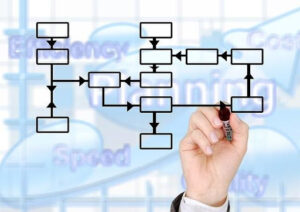The Anatomy of SaaS Pricing Strategy
Pricing innovative SaaS services is much more complicated than regular pricing, giving developers quite the headaches. Unsurprisingly, the SaaS pricing process often resembles a simple number picking instead of a rigorous endeavor.
Whatever the prices you think are, the prices will range from one that is far from high enough in the market to create a demand and one that is low enough for a budget to cover the cost of the product. You won’t be able to tell whether your customer likes and requires your service.
3 Popular SaaS Pricing Strategies
A pricing strategy based on SaaS stretches from a random selection of numbers in a single area of the spectrum to fully optimized, value-oriented plans in a second. Think of pricing like a game
of darts: you can randomly throw your arrow or target specific points on the board. It does not need to be complicated to get optimum profits. Each below-listed pricing strategy is appropriate for different business sectors, but SaaS is an effective solution that uses price as the sole option.
Cost-plus pricing
Cost-plus pricing was what everyone instantly remembered when it came to a pricing system. Pricing consists of three essential elements: calculate your entire cost, calculate the average profit margin, and then set your prices. These costs may include product creation and design, own company providers, and team costs for a SaaS company. Going on the dart analogy, costs-plus-price guarantees that you are at least landing on the board – anything less is purely speculation.
Value-based pricing
Value pricing is one of the most discussed approaches. Instead of looking into yourself or toward a competitor with value-based pricing, the customer looks outward. You want information on pricing from those customers whose prices you are deciding on. Value-based pricing is beneficial for clients that want to understand your business. You can offer packages and pricing that are tailored for them since you understand the wants of your consumers.
Competitor-based pricing
Competition-based pricing can bring you close to an attractive price. It is especially useful for new companies that have not yet figured it out or have no sales data supporting them to determine their value. Unfortunately, using the competitor pricing method is less than optimal.
Why It’s Crucial to Nail your SaaS Pricing?
Most SaaS vendors have either an instinctive pricing plan or never take a second look. The company may be afraid of scaring prospective consumers, or they may have no choice but to change the business model and grow its profitability.

Your company will not be able to control the price of its product, but your customers can get a new revenue source by investing in your product.
Strengthen your SaaS unit economics
SaaS success depends on two metrics: customer lifetime value (LTVs) and customer acquisition cost (CAC). The minimum LTV must exceed CAC. Otherwise, the LTV won’t be increasing as fast as possible. Optimizing your SaaS prices can reduce your CAC by better positioning, packaging, and targeting ideal consumers and improve LTV by raising prices and improving retention. What are the results? Better SaaS product, faster growth, and higher profit margins.
Unlock an untapped growth lever
Monetizations have far more significant impacts than acquisitions. We found that monetization was 4x more efficient when enhancing growth compared to acquisitions and 2x less costly compared to efforts to improve retention. In doing so, you’re giving your SaaS organization a greater chance to succeed.
Provide actual value for customers
Most consumers want to buy products for which they have a good reason and buy things they can easily recall. Choosing the prices your customer wants means pricing based on value, not the cost of your product/service. This is something we can go into later.
Gain a competitive advantage
Many companies you’ll likely be competing against don’t optimize pricing. If you optimize pricing, your company will gain a competitive position—even though the service might cost less.
Pricing Examples
Per User Pricing Example
The SaaS product plan has been developed as the most straightforward and cost-efficient solution. The only variable of their business plans is that they add the number of users to the accounts, and the prices for each user are the same regardless of the group size.
Examples of Flat Rate Pricing
Examples of flat rate pricing are very few and far between, but it is still being utilized on eCommerce CartHook. The annual fee for each month for the entire product is $300. This provides complete access to every product of the company.
Examples of Usage-Based Pricing
Pricing is particularly effective with recurring billing solutions like Chargify by correlating price directly with revenues so that price increases only occur in periods where revenue increases are constant.
Tiered Pricing Example
HubSpot, a SaaS content marketing platform, utilizes a tiered pricing system to great advantage: each tier is based around a particular market and varies according to needs and budgets.
Example of Freemium Pricing
Chat SaaS Drift uses free premium pricing for its products. The Free Package gives small businesses the chance to get a free chat with 100 contact lists.
The 4 steps that make up a great SaaS pricing process
Price analysis is an ongoing step until the SaaS business has found a viable pricing plan. ProfitWell’s processes cover four main phases: problems, causes, solutions, and implementation.

Cause: Use data to discover the root cause of these issues
It is necessary to find the true causes of this disease. The customer is your only source that can answer the question of why your product is so expensive in terms of price. Sadly, most SaaS businesses often skip it for 3 reasons:
- Time is needed.
- It is scary.
- They thought there was an answer.
The data you collect from customers can help you identify where your company fails and how your business is doing. It requires shrewd effort.
Solution: Use data-driven experiments to test viable solutions
Testing your hypothesis and collecting data are essential in determining your long-term pricing and evaluating its effectiveness. By regularly testing minor changes, it’s simple to obtain reliable information regarding a particular theory. You can see how things work or not and only require time for the permanent implementation of a change that maximizes growth and revenues. Now, if you are a subscription business using dedicated billing software, you could simplify this step even more. For instance, PayPro Global allows its users to AB test pricing strategies and collect
relevant data thanks to its reporting capabilities. This lets you better understand how your customers relate to your product’s price.
Problem: find the main obstacles your company is facing
Is it something preventing you from gaining more customers for your product? The question seems obvious to the naked eye, but the answer is complex. You may face challenges related to your product, staff, or customers. And while you cannot control all of them, it would be wise to focus on those you can. And one of those is improving SaaS pricing strategies.
Implementation: put the best solutions into action
You can then use these data for price analysis. All your pricing processes are about this, but there is something brands rarely follow up on: data implementation. It’s terrifying for SaaS companies to face significant price changes. Do consumers dread new pricing? Can acquisitions be lowered off the cliff? With quantified buyer personas, however, you can make those changes quickly.
Conclusion
Saas billing models are a great way to make money. There are many different saas billing models, each with advantages and disadvantages. You should choose the model that is best for your business. We can help you find the suitable model and set it up so you can start making money immediately. Have you tried out any of these saas billing models?











